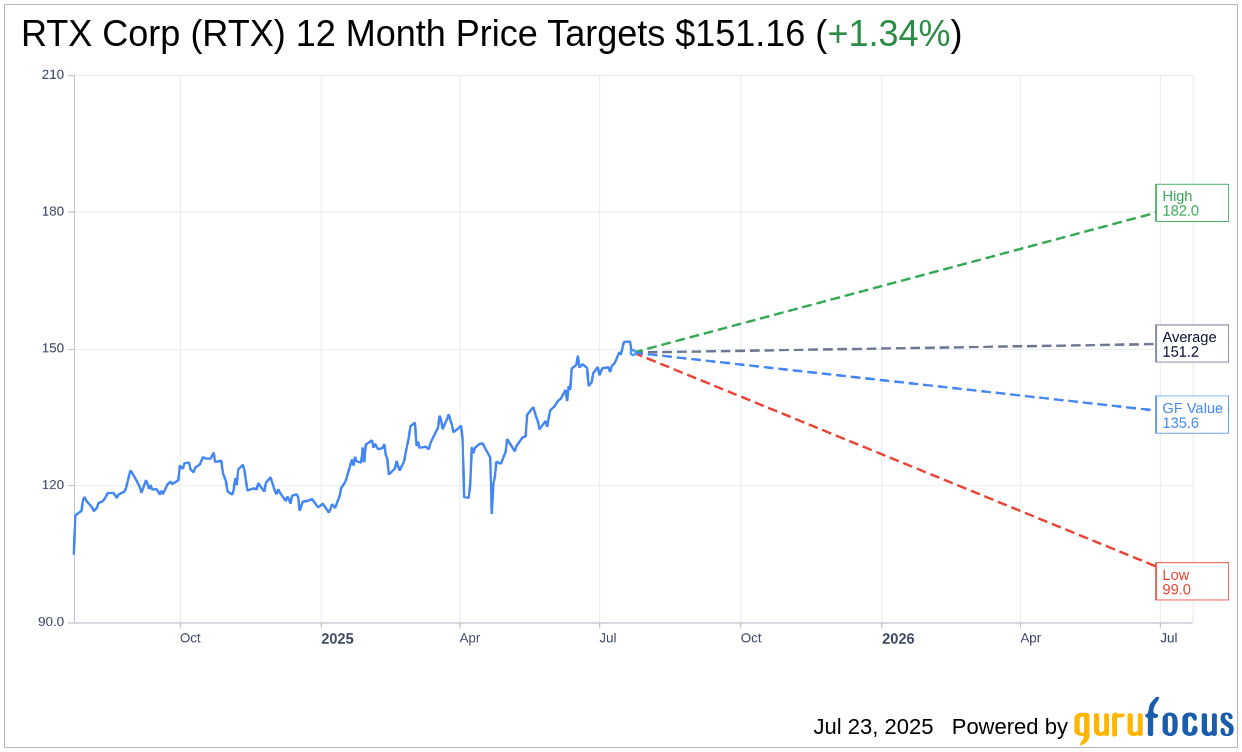UBS has increased its price target for RTX from $166 to $177 while maintaining a Buy rating. According to an analyst's note, RTX has shown consistent operational progress and offers a compelling valuation.
Wall Street Analysts Forecast

Based on the one-year price targets offered by 21 analysts, the average target price for RTX Corp (RTX, Financial) is $151.16 with a high estimate of $182.00 and a low estimate of $99.00. The average target implies an upside of 1.34% from the current price of $149.17. More detailed estimate data can be found on the RTX Corp (RTX) Forecast page.
Based on the consensus recommendation from 25 brokerage firms, RTX Corp's (RTX, Financial) average brokerage recommendation is currently 2.2, indicating "Outperform" status. The rating scale ranges from 1 to 5, where 1 signifies Strong Buy, and 5 denotes Sell.
Based on GuruFocus estimates, the estimated GF Value for RTX Corp (RTX, Financial) in one year is $135.57, suggesting a downside of 9.12% from the current price of $149.17. GF Value is GuruFocus' estimate of the fair value that the stock should be traded at. It is calculated based on the historical multiples the stock has traded at previously, as well as past business growth and the future estimates of the business' performance. More detailed data can be found on the RTX Corp (RTX) Summary page.
RTX Key Business Developments
Release Date: July 22, 2025
- Organic Sales Growth: Up 9% year over year.
- Commercial Aftermarket Growth: Increased by 16% year over year.
- Segment Operating Profit: Up 12% year over year.
- Free Cash Flow: Approximately breakeven for the quarter.
- Book-to-Bill Ratio: 1.86 for Q2.
- Backlog: $236 billion, up 15% year over year.
- Adjusted Sales: $21.6 billion, up 9% on both adjusted and organic basis.
- Adjusted EPS: $1.56, up 11% from the prior year.
- GAAP EPS from Continuing Operations: $1.22.
- Free Cash Flow Outflow: $72 million for the quarter.
- Full Year Adjusted Sales Outlook: Increased to $84.75 billion to $85.5 billion.
- Full Year Adjusted EPS Outlook: Revised to $5.80 to $5.95.
- Full Year Free Cash Flow Outlook: Maintained at $7 billion to $7.5 billion.
- Collins Sales: $7.6 billion, up 9% on both adjusted and organic basis.
- Pratt & Whitney Sales: $7.6 billion, up 12% on both adjusted and organic basis.
- Raytheon Sales: $7 billion, up 6% on both adjusted and organic basis.
For the complete transcript of the earnings call, please refer to the full earnings call transcript.
Positive Points
- RTX Corp (RTX, Financial) reported a 9% organic sales growth year over year, with a notable 16% increase in commercial aftermarket sales.
- The company achieved a book-to-bill ratio of 1.86, indicating strong demand and a growing backlog now standing at $236 billion.
- RTX Corp (RTX) secured significant orders, including over 1,000 GTF engine orders and $5 billion in integrated air and missile defense awards.
- The company is expanding its regional partnerships in Europe, enhancing its production capabilities and market reach.
- RTX Corp (RTX) raised its dividend by 8%, reflecting confidence in its long-term cash generation capabilities and commitment to returning capital to shareholders.
Negative Points
- Free cash flow for the quarter was approximately breakeven, impacted by a four-week work stoppage at Pratt & Whitney.
- The company faces a $500 million tariff cost for 2025, despite mitigation efforts, which affects its earnings outlook.
- Adjusted EPS outlook was revised down to a range of $5.80 to $5.95 due to tariff headwinds, from a prior range of $6 to $6.15.
- Pratt & Whitney's operating profit growth expectations were lowered due to the impact of tariffs and the work stoppage.
- RTX Corp (RTX) is dealing with ongoing supply chain challenges, particularly in structural castings and isothermal forgings, which could impact production and MRO output.
